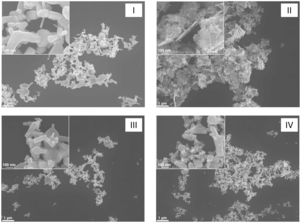Zinc oxide nanoparticle

Zinc oxide nanoparticles are nanoparticles of zinc oxide (ZnO) that have diameters less than 100 nanometers. They have a large surface area relative to their size and high catalytic activity. The exact physical and chemical properties of zinc oxide nanoparticles depend on the different ways they are synthesized. Some possible ways to produce ZnO nano-particles are laser ablation, hydrothermal methods, electrochemical depositions, sol–gel method, chemical vapor deposition, thermal decomposition, combustion methods, ultrasound, microwave-assisted combustion method, two-step mechanochemical–thermal synthesis, anodization, co-precipitation, electrophoretic deposition, and precipitation processes using solution concentration, pH, and washing medium. ZnO is a wide-bandgap semiconductor with an energy gap of 3.37 eV at room temperature.[1]
ZnO nanoparticles are believed to be one of the three most produced nanomaterials, along with titanium dioxide nanoparticles and silicon dioxide nanoparticles.[2][3][4] The most common use of ZnO nanoparticles is in sunscreen. They are used because they effectively absorb ultraviolet light, but possess a large enough bandgap to be completely transparent to visible light.[5] They are also being investigated to kill harmful microorganisms in packaging,[6] and in UV-protective materials such as textiles.[7][8] Many companies do not label products that contain nanoparticles, making it difficult to make statements about production and pervasiveness in consumer products.[9]
Since ZnO nanoparticles are a relatively new material, there is concern over the potential hazards they can cause. Because they are very tiny, nanoparticles generally can travel throughout the body, and have been shown in animal studies to penetrate the placenta, blood–brain barrier, individual cells, and their nuclei. Tissues can absorb them easily due to their size which makes it difficult to detect them. However, human skin is an effective barrier to ZnO nanoparticles, for example when used as a sunscreen, unless abrasions occur. ZnO nanoparticles may enter the system from accidental ingestion of small quantities when putting on sunscreen. When sunscreen is washed off, the ZnO nanoparticles can leach into runoff water and travel up the food chain. As of 2011 there were no known human illnesses resulting from any engineered nanoparticles.[5]
See also[edit]
References[edit]
- ^ Kumar, Surabhi Siva; Venkateswarlu, Putcha; Rao, Vanka Ranga; Rao, Gollapalli Nageswara (2013-05-07). "Synthesis, characterization and optical properties of zinc oxide nanoparticles". International Nano Letters. 3 (1): 30. Bibcode:2013INL.....3...30K. doi:10.1186/2228-5326-3-30. ISSN 2228-5326.
- ^ Zhang, Yuanyuan; Leu, Yu-Rui; Aitken, Robert J.; Riediker, Michael (2015-07-24). "Inventory of Engineered Nanoparticle-Containing Consumer Products Available in the Singapore Retail Market and Likelihood of Release into the Aquatic Environment". International Journal of Environmental Research and Public Health. 12 (8): 8717–8743. doi:10.3390/ijerph120808717. PMC 4555244. PMID 26213957.
- ^ Piccinno, Fabiano; Gottschalk, Fadri; Seeger, Stefan; Nowack, Bernd (2012-09-01). "Industrial production quantities and uses of ten engineered nanomaterials in Europe and the world" (PDF). Journal of Nanoparticle Research. 14 (9): 1109. Bibcode:2012JNR....14.1109P. doi:10.1007/s11051-012-1109-9. ISSN 1388-0764. S2CID 55419088.
- ^ Keller, Arturo A.; McFerran, Suzanne; Lazareva, Anastasiya; Suh, Sangwon (2013-06-01). "Global life cycle releases of engineered nanomaterials". Journal of Nanoparticle Research. 15 (6): 1692. Bibcode:2013JNR....15.1692K. doi:10.1007/s11051-013-1692-4. ISSN 1388-0764. S2CID 97011693.
- ^ a b Kessler, Rebecca (2011-03-01). "Engineered Nanoparticles in Consumer Products: Understanding a New Ingredient". Environmental Health Perspectives. 119 (3): A120–A125. doi:10.1289/ehp.119-a120. ISSN 0091-6765. PMC 3060016. PMID 21356630.
- ^ Iosub, Cristina Ş.; Olăreţ, Elena; Grumezescu, Alexandru Mihai; Holban, Alina M.; Andronescu, Ecaterina (2017), "Toxicity of nanostructures—a general approach", Nanostructures for Novel Therapy, Elsevier, pp. 793–809, doi:10.1016/b978-0-323-46142-9.00029-3, ISBN 9780323461429
- ^ Noorian, S. A., Hemmatinejad, N., & Navarro, J. A. (2020). Ligand modified cellulose fabrics as support of zinc oxide nanoparticles for UV protection and antimicrobial activities. International journal of biological macromolecules, 154, 1215-1226. https://doi.org/10.1016/j.ijbiomac.2019.10.276
- ^ Noorian, Seyyed Abbas; Hemmatinejad, Nahid; Bashari, Azadeh (May 2015). "One-Pot Synthesis of Cu 2 O/ZnO Nanoparticles at Present of Folic Acid to Improve UV-Protective Effect of Cotton Fabrics". Photochemistry and Photobiology. 91 (3): 510–517. doi:10.1111/php.12420.
- ^ Hull, Matthew S.; Rejeski, David Jr; Hochella, Michael F.; McGinnis, Sean P.; Vejerano, Eric P.; Kuiken, Todd; Vance, Marina E. (2015-08-21). "Nanotechnology in the real world: Redeveloping the nanomaterial consumer products inventory". Beilstein Journal of Nanotechnology. 6 (1): 1769–1780. doi:10.3762/bjnano.6.181. ISSN 2190-4286. PMC 4578396. PMID 26425429.
